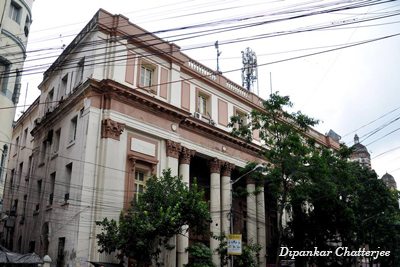
The site of the Royal Exchange, located at 6 NS Road in Dalhousie area, was once occupied by a residential building, used by the European officials. The earliest known occupant of the premises was Mrs. Beard, widow of Charles Beard, whose father John was the President of Bengal and added the North East bastion to the Old Fort William. After that, Robert Clive used to stay in the building and subsequently, the adjacent road was named after him. Next occupant, Philip Francis, member of the Supreme Council of Bengal, was the chief antagonist of Warren Hastings on the Council and their disagreements led to the famous duel, in Alipore, near the present National Library Building.
According to Francis, it was the finest house in Bengal and he used to pay an annual rent of £ 1200 for it. Sometime after 1842, the premises were purchased by the Oriental Bank Corporation, which was liquidated in 1892.

Earlier to that, Calcutta Chamber of Commerce was founded in 1834 and they were housed in the buildings of the Bengal Bonded Warehouse, on Clive Street. By 1853, the Calcutta Chamber of Commerce was reconstituted to form the Bengal Chamber of Commerce. With increasing number of members they were desperately in need of a more spacious office. Therefore, the decision was taken to purchase the building of the Oriental Bank Corporation and they shifted to the said premises. Soon, that too was proved to be inadequate. Ultimately, on the occasion of the Chamber’s Golden Jubilee in 1903, the decision was taken to build a new headquarters in place of the existing building. Accordingly, in 1914, the Bengal Chamber moved to their temporary office on 20 Strand Road, while the old building was demolished and the new Royal Exchange was built.

Constructed in Grecian architectural style, the Royal Exchange was designed by T S Gregson of M/s Gregson, Batley &. King (Architects), Bombay. The foundation stone was laid in 1916 by Lord Carmichael and the structure was raised by JC Bannerjee &.Co of Calcutta. It was completed at a cost of Rs. 500,000 and formally opened in 1918 by Lord Ronaldshay.
Located at the corner of NS Road (former Clive Street) and Royal Exchange Place (India Exchange Place), opposite to the majestic Chartered Bank Building, the building of Bengal Chamber of Commerce still bears the name ‘Royal Exchange’ in gigantic letters on its façade. The square, colonnaded office of the Bengal Chamber of Commerce, the oldest such body in India, has a grandeur of its own. Subsequently, the grilles were erected around the columns to protect the ground floor, from the outsiders. The top of the Southern face of the building bears the Royal coat-of-arms, in the form of a shield, flanked by a lion on the left, a unicorn on the right, and topped by a lion. The base of the monogram is inscribed with the Latin phrase ‘Dieu et mon droit’, means God and my right.

The Royal Exchange was accommodated on the ground floor of the grand building, which was used by the traders for their business purposes. Bengal Chamber had its offices on the upper floor. The grand staircase, leading to the upper floor, is lined with marble. A corridor is lined with black-and-white photographs of the past presidents. Old clocks, prints, statuettes and sundry Victoriana are strewn all over.

An interesting relic is still preserved in the Chamber in the shape of what is known as the ‘Mutiny Gate’. It was placed on the upper staircase during the disturbed period of Sepoy revolt in1857 by the then Manager of the Oriental Bank Corporation, which at that time occupied the building.
Probably, the gate was installed as a protection and safeguard against any possible attack. However, Calcutta did not face any such disturbance during the related period and never there was any need to close the gate.
